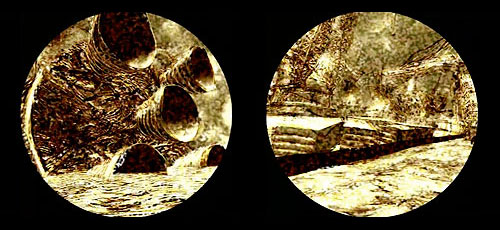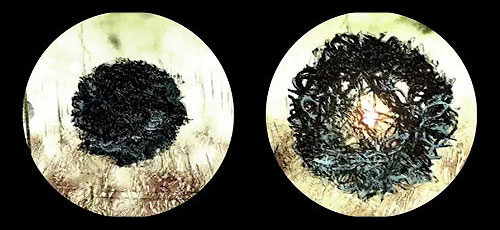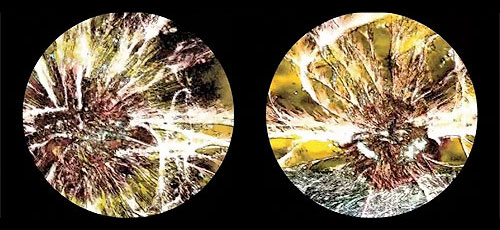EXCLUSIVE: Matthew Ritchie discusses the apocalyptic themes in his videos The Iron City (2007) and Raphael (2007), featured in his upcoming exhibition The Morning Line (2008) for the 3rd Bienal Internacional de Arte Contemporáneo de Seville. The Morning Line will be on view October 2, 2008 – January 11, 2009 at the Centro Andaluz de Arte Contemporáneo in Seville, Spain.
Matthew Ritchie’s artistic mission has been no less ambitious than an attempt to represent the entire universe and the structures of knowledge and belief that we use to understand and visualize it. Ritchie’s encyclopedic project (continually expanding and evolving like the universe itself) stems from his imagination, and is cataloged in a conceptual chart replete with allusions drawn from Judeo-Christian religion, occult practices, Gnostic traditions, and scientific elements and principles.
Matthew Ritchie is featured in the Season 3 (2005) episode Structures of the Art:21—Art in the Twenty-First Century television series on PBS.

ART21: Could you say a little about the inspiration behind the videos The Iron City (2007) and Raphael (2007) that will be featured in your upcoming project The Morning Line (2008)? Isn’t part of the organizing principle behind the works John Milton’s Paradise Lost (1674)? What drew you to a text that’s over 300 years old?
RITCHIE: Paradise Lost is one of the great books that nobody’s ever read. It’s the greatest epic poem in the English language — everyone agrees — but nobody can get through it because it’s like ninety percent junk. But what it really is, when you spend a little time with it, is an index to all these myths. Milton doesn’t just tell the great story of the Judeo-Christian tradition; he also goes to great lengths to include all of the Greek myths and all of the Persian myths and all of the Egyptian myths. Everybody gets a name check, and he gives all the gods little jobs to do inside the new hierarchy.
All of the religions of the world before Christianity foresaw enormous cycles of activity. The world would be destroyed, it would be rebuilt, it would be destroyed, it would be rebuilt. There was always this anticipation that not only were the gods born out of some vast violent cataclysm, but they would then die in an equally vast violent cataclysm. Milton’s making an argument that Judeo-Christian time, or what we would call teleological time, is the first religion to propose an end to that: the world was created, there’s the fall, and then the world will end — the end. In the Judeo-Christian tradition, the world as we know it is not going to come back again; there’s no reincarnation, there’s just Heaven and Hell after that. So Milton is trying to grapple with this enormous new tradition and bring it into some kind of order that includes all the previous traditions. And he’s also trying to include all of the scientific stories of his day as well, which is why there are these subsets on mining and on architecture. It’s like an encyclopedia of all of the interests of society at the time.
Milton’s text was also the first great result of the Enlightenment, which in England took shape as the Republican overthrow of the Anglo-Catholic monarchy, which was the last generation to believe in the Divine Right of Kings. The Divine Right of Kings was entirely literal. It meant members of the ruling class were the direct descendants of God on earth and they could therefore do whatever they wanted. And with Republicanism what you have is a new generation of people saying, “No, that doesn’t make any sense, we’ve got to change this.” So Paradise Lost is simultaneously a political text, an ideological text, a deeply religious and spiritual text, and an attempt to encyclopedically wrap up all of the loose ends of the Bible and re-present them in the light of anthropology and history and ethnography and say, “Okay, here it is — here, finally — here’s all you need to know. Here’s how it all works.”
The kind of thing that was very new in Milton’s time — this idea that human beings had the right to challenge divine authority — has now reached a kind of limit case where, for the last hundred years, it’s been approaching the logical conclusion that “human beings” means every single human being. Because in Milton’s day “human beings” didn’t really include women, it didn’t include slaves, it didn’t include serfs, it didn’t include people who didn’t have property, it didn’t include lots of people. It really meant a small, educated class of people could substitute themselves for the monarchy. But this new class was still in a kind of covenant with God. And this has radically changed, today, because the premise of universal enfranchisement has broadened to include all the people who don’t claim to have a covenant with God, which is everybody else in the world. So with Paradise Lost you have this incredible opportunity to experience something that’s sort of like the time we’re in now: this changeover between a kind of outmoded, late 19th century Republicanism — which has become a kind of residue — and something even more radical. Paradise Lost provides a very strong analogy to the intense historical period we are living in today.

ART21: How are the films and structure of The Morning Line itself influenced by Paradise Lost?
RITCHIE: What I’m trying to do for the piece, as a whole, is to invert this idea of information we all seem to share: that the more information you have, the more you know. I don’t think that’s necessarily the case. Information is really just the stuff the universe is made of and the more you have of it doesn’t necessarily mean the more you know about it. It just means the more you have. So this piece is very much about a lot of very complex ideas that we believe are models of the universe. It takes this theory called the ekpyrotic scenario, which is the idea that the universe is constantly rebuilding itself or rebooting itself every few millennia. It takes the theories of Paradise Lost, it takes the theory of scale invariance, it takes all these kinds of very rich ideas and it says, “Well, what does that look like? What would that be if you turned it into a thing?”
In Milton’s case, he begins the story of Paradise Lost with Satan fallen to Hell. Hell is described as an enormous furnace, but it’s not lit with light but with “darkness visible.” So again, what does “darkness visible” look like? We have a term for that nowadays: it’s called dark matter. Dark matter is what holds the universe together. We can’t see it and we don’t know where it is, but it’s obviously a kind of geometry that ties everything together. The Morning Line is an attempt to build something that is Lucifer’s palace in Hell, which is called Pandemonium, where the demons build out a literal fabric of invisibility into something that they can then inhabit. For the demons it becomes a record of where they came from; it’s a kind of anti-Heaven.
The films tell the story of a universe that is being built and torn apart. First the universe assembles itself into a garden, and it’s sort of like the beginning of the world. In The Iron City (2007), gradually that world decays and falls apart and is turned into a kind of ruined city, which is the world we’ve created. And then that ruined city transforms gradually into The Morning Line, which then dissolves back to the beginning of time and the whole thing becomes a kind of endless narrative loop. The films reflect, simultaneously, the very small scale of universe — as built from tiny particles — and the very big scale of the universe — which is really just lots more of the small parts of the universe put together. This gets back to the idea that the more information you have doesn’t necessarily mean you’re really learning anything more, it just means you’re seeing more of the same things articulated through different laws.

ART21: The process of making an animated film has similar shifts in scale: there’s individually drawn images or cells, and then when seen together in sequence, they are more than simply a sum of the parts. Do you see a connection between the medium of film and this idea of information?
RITCHIE: Generally, my work is about drawing and so making the films was a particular interest of mine. From the very start, I’ve been working with digital technology and with the idea that what you have in digital environment is a particle instead of a line. When you make something digital you make it out of little dots. And you can make lines out of particles, but they’re really just bits. I’ve always been fascinated with how dots coalesce into lines, and with the question of is there a difference between a pixel and a line? These are the classic forms of dimensionality — the point, the line, the solid — and then you add time and you’ve got the universe.
When I started working with digital technology it was about taking information, taking drawings, putting them into the computer, and making them do things. Initially there wasn’t really the available technology to create a space with depth. And then gradually, in Proposition Player (2003), we started to play with this idea of a cartoon depth where there was this shallow space. And then I was able to push that further by really building the equivalent of a game space or a world which is composed of particles that you can summon the universe out of. So in the films there’s a world that exists and you fly around inside it and it has behaviors and weathers and things like that. It’s made out of my drawings, transcribed by an animator, into three-dimensional objects. But the objects themselves are just drawings again, they’re just lines, and what cloaks them is the particles. So the typical relationship that goes from point to line has been inverted, and now it’s like the line is cloaked in the points.

ART21: How does the narrative for the videos and The Morning Line connect to Milton’s worldview?
RITCHIE: The narrative for The Morning Line proposes a historical continuum of ideas from Milton’s time up to today. Milton lived in the 17th century when the narrative options were either a religious world or the world of fantasy. Those are the only imaginary worlds that people could move in; it’s before the novel has begun to exist. There’s the world of God, the world of demons, and then there’s the world of folklore, and the three have a sort of uneasy relationship with each other.
By the time you get to the 19th century, science begins to emerge and you get the first scientific fiction — what we today would call science fiction. You have Mary Shelley, who wrote the first apocalyptic novel called The Last Man (1826). We’re still telling that story, only now it’s the movie I Am Legend (2007). It’s like we haven’t moved one inch from that point. What science fiction really provides is a new liberty for political imagination.
In the time of Milton, if you wanted the world to be a better place, you could only imagine it to be God’s world on earth, a New Jerusalem. By the 19th century, you start to have the possibility to imagine a scientific utopia that is not being generated by God but by time itself. Scientific fiction fuses utopic thinking and politics together into a vision of a future world. So from Jules Verne to Karl Marx…they’re all operating at exactly the same timeframe. It’s really the first time in history you’ve been able to mentally project forward without religion.
Why is it that we’ve abandoned that sort progress? What happened to that message? What seems to have happened to the idea of progress in the last three hundred years is that the typical figure of the light bringer, the Promethean figure, has been transposed into the figure of the adversary, the Satanic figure. The two figures are linked together so that now any agent of substantial change — like Karl Marx, for instance — is derided as inherently, essentially evil. Capitalism, whose preferred model is not the equal distribution of goods — which would be sort of God’s kingdom on earth — is very much anti-New Jerusalem. The endless consumption of goods has gone hand in hand with an apocalyptic Christianity — which seeks the teleological end of things — to create a vision of the future where the only desirable end is the Apocalypse, because that is what finally brings things to an end. From the evangelical Christian point of view, the apocalypse brings an end to the consumption. And from the capitalist point of view, the apocalypse provides the mechanism for endless consumption.
There’s been a conscious embrace by two dynamically different wings of society, you could say the two founding agencies for America. There are the arch-capitalists who have absolutely no interest in a New Jerusalem on earth. And then there are very sincere people of faith who find a common cause in opposing Communism and other bankrupt totalitarian nightmares. The two have been joined up very nicely into a model for our imagination, which is this endless apocalyptic fantasy world, which is what all the movies really represent now. The entire fantasy spectrum of people’s imaginary life is governed by one apocalypse after another.
This fantasy becomes a very useful tool. I don’t think it’s coincidental that it’s deployed by government; it’s just simply opportunistic that it happily works as a tool for social control. But that’s really just a side effect of the much longer, larger term plan which is to simply keep these two things working seamlessly together. Everyone’s simultaneously scared. And what should you do when you’re scared? You should buy more things. It’s a perfect balance of forces that creates this endless apocalyptic landscape.
What’s inherent in the apocalyptic fantasy is the logical conclusion that we will reach a time when time itself is exhausted, whether or not that brings a New Jerusalem on earth or simply the end of things. And it’s quite clear that we are depleting the resources of the earth at a very rapid rate. After that will come the time that was first envisioned in all of the early scientific fiction, which is after we’ve run it all down to the ground there’ll be this incredible moment where the earth is empty again. It’s used up, but it won’t be less beautiful for that. There’s a book called The World Without Us (2007) by Alan Weisman that describes how quickly the world would revert back to its natural state if human beings all vanished. I think we can begin to see now, emerging out of this vast conflagration, that there is going to be a time of ruin but also a time of possibly recovery. The story doesn’t have to end at the apocalypse. I think it’s important to go beyond that moment of endlessly sustained fear and complicity in the excitement of that fear.
VIDEO | Producer: Eve Moros Ortega and Nick Ravich. Camera: Joel Shapiro. Sound: Judy Karp. Editor: Jenny Chiruco. Artwork Courtesy: Matthew Ritchie and Aranda/Lasch. Thanks: Benjamin Aranda.
PHOTO | All works: Matthew Ritchie, (top) The Iron City, 2007; (bottom) Raphael, 2007.



